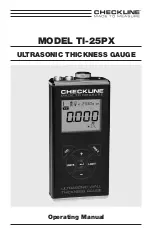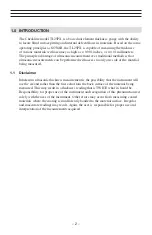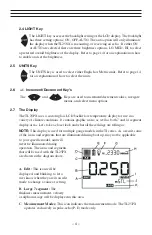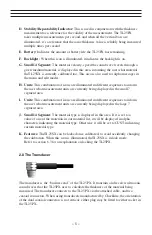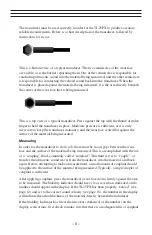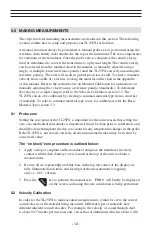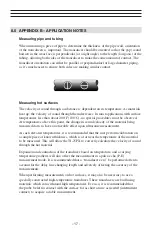
–11 –
4.0 SELECTING THE MEASUREMENT MODE
4.1 Which mode & transducer do I use for my application?
High penetration plastics and castings
: The most common mode for these types
of applications is pulse-echo. Cast iron applications require 1 – 5MHz frequencies, and
cast aluminum requires a 7 – 10MHz frequency depending on the thickness. Plastics
typically require lower frequencies depending on the thickness and make-up of the
material as well. Larger diameters offer greater penetration power based on the size of
the crystal.
Corrosion & Pit Detection in steel and cast materials
: Pulse-echo mode is
commonly used for locating pits and defects. Typically a 5MHz transducer, or higher,
will be used for these types of applications. Use low frequencies for greater penetration
and use higher frequencies for better resolution.
Measuring Material & Coatings
: The pulse-echo coating mode should be used
when both material and coating thickness are required, while still requiring the ability
to detect flaws and pits. A special coating style transducer is required for use in this
mode. There are a variety of coating transducers in various frequencies available from
Electromatic.
Thru Paint & Coatings
: Often times, users will be faced with applications where
the material will be coated with paint or some other type of epoxy material. Since the
velocity of the coating is approximately 3 times slower than that of steel, pulse-echo
mode will result in an error if the coating or paint is not completely removed.
Thin materials
: Pulse echo mode and a high frequency transducer is commonly used
for these types of applications. The most common transducers are the 7.5MHz and
10MHz models with extra resolution. The higher frequencies provide greater resolution
and a lower minimum thickness rating overall.
High temperature
: Special 5 MHz High temperature transducers are available for
these types of applications. Both pulse-echo and echo-echo modes will also work for
these applications. However, echo-echo mode will eliminate error caused by temperature
variations in the transducer.
Noisy Material
: Materials such as titanium, stainless steel, and aluminum may
have inherent surface noise issues or mirroring effect. Higher frequency transducers
7 – 10MHz offer improved resolution to avoid erroneous measurements.
Restricted access
: Measuring materials with extreme curvatures or restricted access
are best suited for higher frequencies and smaller diameter transducers.
Содержание TI-25PX
Страница 1: ...MODEL TI 25PX ULTRASONIC THICKNESS GAUGE Operating Manual ...
Страница 21: ... 20 9 0 NOTES ...
Страница 22: ......

